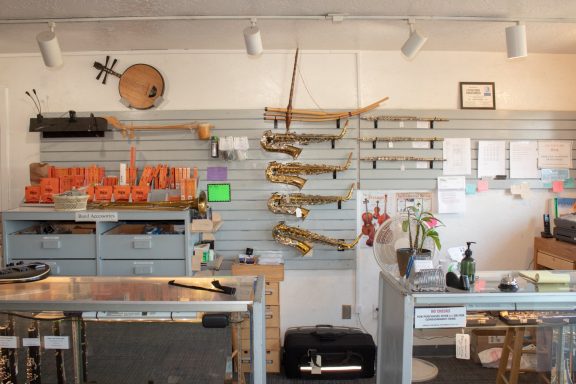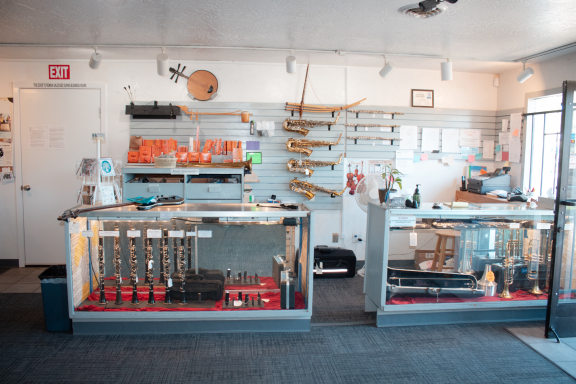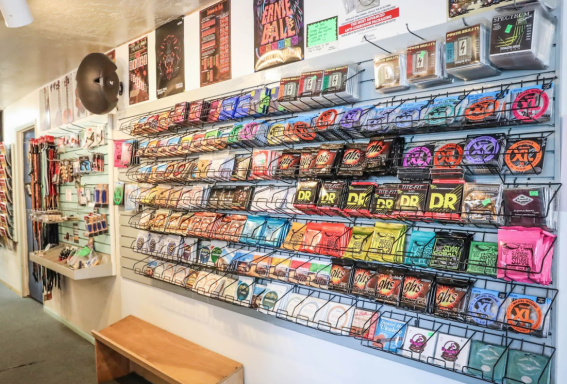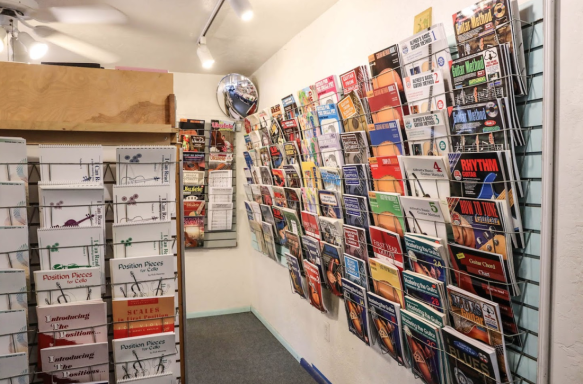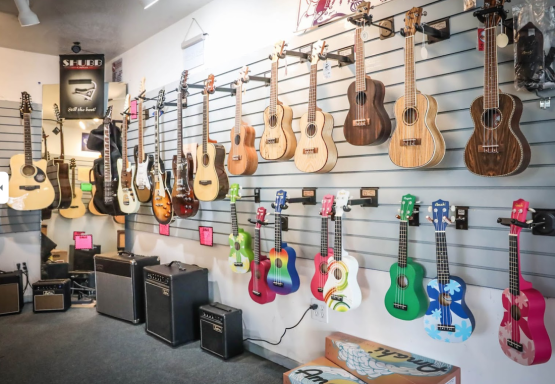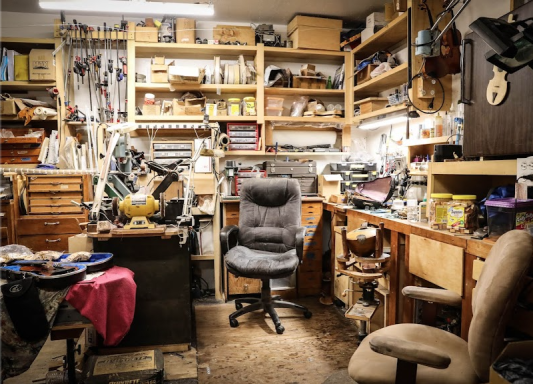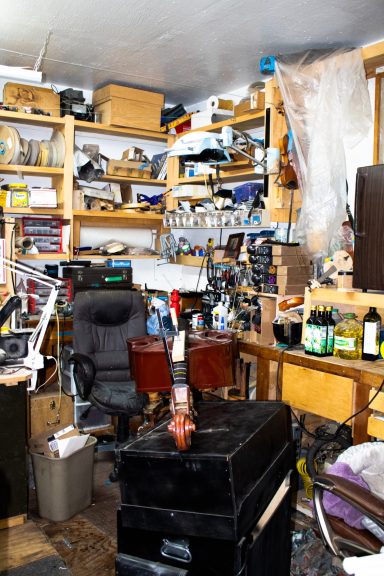A Tale of Two Shops: Retail & Workshop
Pete's Music Center is the retail shop for
Instruments, Equipment, and Music Books
You can find many musical instruments and items for sale at Pete's Music Center!
We have a large selection of guitar strings, guitars, straps, ukuleles, amplifiers, and electric cables. You will find a detailed selection of music books for every instrument, including method books, theory books, scale and exercises books, Suzuki string books, and pop music books.
Band items include reeds, straps, mouthpieces, and drum sticks. We also have for sale acoustic and electric guitars, string, brass, and woodwind instruments. All instruments are of high quality and have been carefully set up by our specialists.
Pete's Workshop:
Bow Rehair
After using my existing modified catalog-purchased re-hair jig for 17 years and about 800 bows, I decided to copy the attributes of and add amenities to the old jig to greatly improve the original (just call me a slow learner!)
According to the two local string instructors that I respect most, my bow re-hairs were not of consistent quality, so I decided to proactively build a jig that would allow me to meet their expectations. Even with the magnetic tool holder over the bench top, I knew that I needed more storage space on the new version for small parts.
There were several improvised additions to the old jig that were not conformed correctly, namely the upper shaft support, the vise assembly locking the shaft just above the frog, and most importantly, the new-hair alignment and lateral hair spread plates, since my two “consultants” insist on a wide ribbon of hair entering the frog D ring.
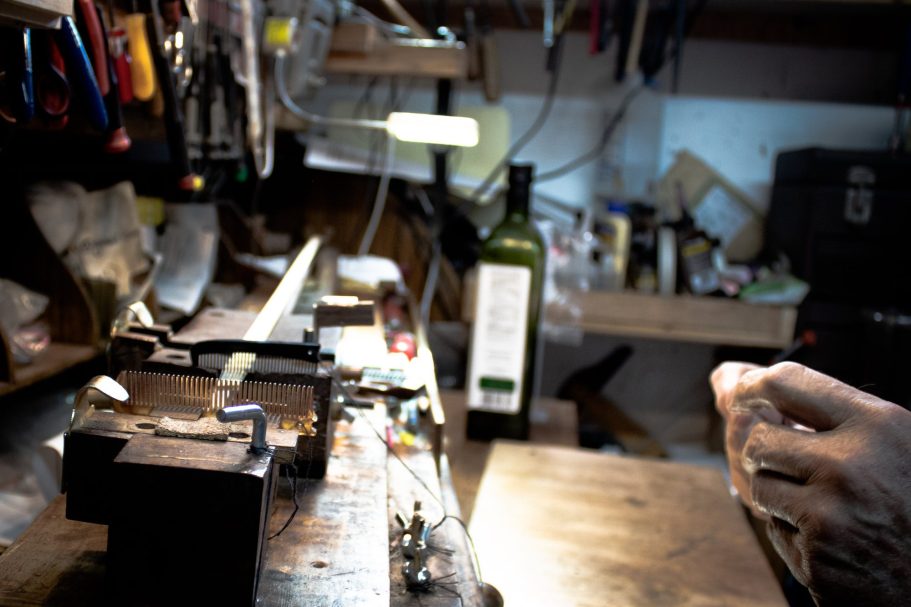
The Bow Jig
In this article, Pete explains how he updated his bow rehair jig.
From the photos, one will notice that there is a base foundation of poplar, although I could have chosen any hardwood for this purpose. Since my bench top cavity was 41” wide, I cut the 7” wide board about 40 3/4” long. Thus, I can actually slide the whole jig under the overhanging accessories shelf with the magnetic tool holder on the face. To this poplar foundation, I assembled a 3 drawer cabinet about 3 ½ “ tall (I.D.) from a piece of 6” wide German beechwood that I found at a local cabinet shop (I actually constructed the sliding drawers last). Notice from the photo that the cabinet is about 5” shorter and approximately centered on the poplar foundation. Thus, I have a formed a longer, slightly broader base under a cabinet for the 3 drawers.
I noticed that the commercially-made “old” jig base containing the daddo for bow length adjustment was constructed of “stringy and porous” oak. Instead, I chose western maple with intense “fiddle-back,” since denser wood is necessary for a smooth-running, waxed slide. After cutting this maple to just under 40 inches long by about 5 inches wide, I cut a dad-do groove on the bottom side, split it down the middle less about 3 inches, and added two shims to form a female T-slide on the bottom side of the maple. The black walnut inlay is about 1/8 inch thick and is designed to resist the maple from splitting linearly. The bow tip receiver and the aft frog receiver are centered and countersunk-screwed on a complementary male slide and generously bees-waxed for dry, smooth lubrication.
The tip slide and the shaft clamp are composed of gun stock-quality of approximately 2 inches thick California black walnut. I have friends who regularly gift me such a resource, though one could easily use maple, hickory, cherry, birch or any other fine-grained hardwood. It is important to avoid laminated plywood for the sliding headstock and shaft vise. Notice the tip block and shaft vise are carefully lined with suede leather. I chose thick hardwood blocks on edge because I needed to construct wide hair clamping beds to satisfy the ribbon requirements of my two string player consultants. From the near-field photo of the vise area, one will notice the cork padding between the black-walnut hair clamping plates with oversized holes drilled for the 1/4 inch studs mounted into the blocks. To reinforce the thin black-walnut plates, I dribbled thin Lock-Tite superglue on the naked wood-- actually it is far better than thin aluminum that I installed on the “old” jig. The far shaft vise block is fixed with screws into the maple base, and there are two 1/4” dowels with a single 1/4” carriage bolt between (with a wing nut for quick clamping and release) to keep the near V block laterally slide-able and parallel. It is important to line the V with high-grade leather suede.
Cold hide glue is a fine adhesive chosen for this purpose. Notice the added frog anvil that facilitates pressing the hair wedge into the frog after slipping the frog D ring over the hair-- a step that I occasionally omit! The slot that holds the inverted hair comb allows for parallel hair alignment. The aft frog receiving unit contains another vertical slot for the frog's hair tension adjustment nut, and another pair of cork-lined hair clamping plates with a second hair comb slot. This aft frog receiving unit is slide-able and clamp-able, thanks to the linear spring in the maple undercarriage. I purchased a common two-piece, spring loaded cam lock mounted on the underside to secure the frog receiving unit in place. A suede “brake” pad was installed to provide “give” to this clamping system (see the near-field photo). It is important to linearly line up all three black walnut blocks on the center of the jig slot using an actual bow. All components were individually oil sanded and then coated with Bulls Eye clear shellac. It is my experience that string players who are past the beginner level insist on parallel hair on their bows. In addition to the two inverted hair combs in the above slots, I also use two smaller comb sections before tying one of each side of the frog hair cavity. Thus, the taper of the bundled hair precisely gathers over the frog hair cavity. I also dry-temper the hair after I remove the hair from the jig and before rosining.
-Pete Van Alstyne, owner
Hours of Operation
- Monday
- Closed
- Tuesday
- 10:00 am – 03:00 pm
- Wednesday
- Closed
- Thursday
- 10:00 am – 03:00 pm
- Friday
- Closed
- Saturday
- 10:00 am – 03:00 pm
- Sunday
- Closed
Designed by ZM © Zechariah Muzio
We need your consent to load the translations
We use a third-party service to translate the website content that may collect data about your activity. Please review the details and accept the service to view the translations.
